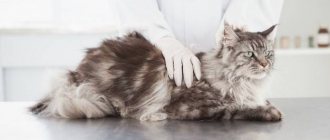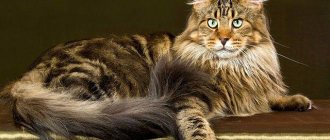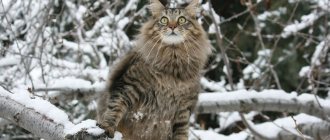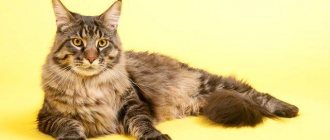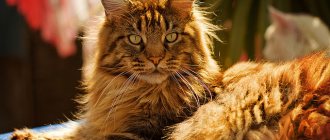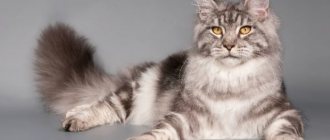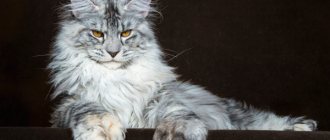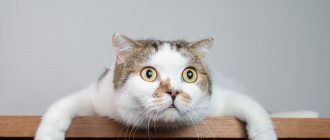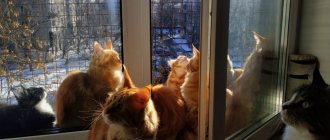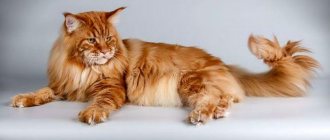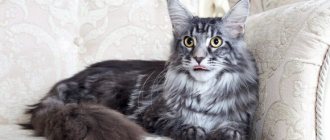First of all, it should be said that hip dysplasia, even if a pet has it, does not necessarily manifest itself sooner or later. For many purrs, this disease does not make itself felt throughout their lives, while for others, its signs begin to appear from an early age. What is this connected with? Firstly, with the physical condition of the animal, and secondly, with the fact that dysplasia can have different degrees of severity, and if the cat has a mild form, then the disease can only be detected during an x-ray.
Description of the disease hip dysplasia in cats
First of all, it should be said that any dysplasia is nothing more than the incorrect formation and subsequent development of a tissue or organ.
As for hip dysplasia itself, not so long ago it was believed that cats do not suffer from it at all.
However, as it turned out, this is far from the case, and that, according to statistics, purebred cats, and, in particular, large cats such as Maine Coon, Norwegian Forest, British and Persian, are most susceptible to this disease.
As for the Scottish Fold, despite the fact that the Scots are much smaller than the British, due to a mutation that causes sagging ear cartilage, this breed is prone to several serious diseases of the musculoskeletal system, among which is dysplasia hip joints.
What is this pathology? The fact is that with this disease, the femur, due to improper formation and development, cannot be correctly combined with the pelvic bones: a free space is formed between it and the pelvic cavity.
This first leads to damage to connective tissue, such as cartilage, and then the bones begin to deform.
Important!
Hip dysplasia cannot be diagnosed at an early age, as it will only manifest itself as the kitten gets older. However, if this disease was diagnosed in close relatives of the baby, then the likelihood of its occurrence in a growing pet will be incomparably higher than if it belonged to a line free from this disease.
Breed predispositions
It is worth noting, first of all, such large cats as the Maine Coon. 18% of this breed suffer from dysplasia.
The following are:
- British;
- Scottish fold;
- Siamese;
- Persian;
- Norwegian forest
Signs
The first signs of dysplasia may begin to appear at an early age. At the very beginning, a young cat may have impaired movement, and this condition only intensifies after physical activity.
Later, as the disease progresses, lameness may develop. The animal becomes inactive due to the pain it experiences; it prefers to lie or sit almost all the time and tries to avoid physical activity.
Over time, the joints affected by the disease enlarge, and during flexion or extension movements, their crunching may even be heard.
Important!
If an animal has only one joint affected, then the muscles on that hind limb may atrophy.
Degrees of bruises
Cat bruises can be classified into four grades.
First degree
A first-degree bruise is characterized by trauma to the inner layers of the skin and subcutaneous tissue. A small wound in the form of an abrasion or scratch may form at the site of the injury. The injured area swells slightly, pain is either insignificant or completely absent. Broken blood vessels may appear on the surface of the skin. Such bruises heal quite quickly, without additional treatment.
Second degree
A second-degree bruise is characterized by the appearance of hematomas, delamination and rupture of muscle tissue, as well as inflammatory edema. Such bruises can cause fever and increased heart rate and breathing.
Third degree
A third-degree bruise is much more life-threatening for a cat. This damage is characterized by a change in the appearance of the animal's skin. Such bruises include injuries to muscles and tendons, fractures and cracks of bones. Injuries are often accompanied by joint dislocation. The first time after a third-degree bruise, the animal experiences shock, then tissue necrosis may develop. If the injury was caused to the head or spinal column, the animal may experience nervous disorders.
Fourth degree
A fourth degree bruise is the most life-threatening for a cat. Such injuries are characterized by complete tissue proliferation and bone fragmentation. As a rule, an infection gets into the injured area, therefore, purulent-putrefactive processes (abscesses, phlegmon, sepsis) can develop. It is almost impossible to restore the damaged part of the body, so they have to be amputated.
Symptoms (photo)
Symptoms of hip dysplasia may include:
- Clumsiness.
- Unsteady gait.
- When performing jumps, a cat gallops like a hare.
- Lameness, especially noticeable after the animal runs or jumps.
- Clearly audible crunching sound when moving.
- The cat doesn’t like to jump on tops; he prefers not to even climb onto a chair or sofa.
- When the cat stands up, the stiffness of her movements is visible.
- X-shaped stance of the hind limbs and muscle atrophy.
How strongly the signs of dysplasia will manifest depends on its degree. There are five of them in total:
- Healthy joint: everything is fine, dysplasia is completely absent
- Minor changes, noticeable only on x-ray.
- Mild pathological changes: at this stage, clinical manifestations of the disease are possible.
- Severe: serious changes can be seen on x-rays, and pronounced clinical symptoms are also present.
- Extremely severe degree: complete destruction of the joint and its dislocation occurs.
Important!
If dysplasia first manifests itself at an early age, then the listed symptoms will be less obvious than if the disease first appeared in the pet’s adulthood.
The degrees of dysplasia are of particular importance for mating tolerances. According to the rules of the World Cat Federation, animals with the first three degrees are allowed for breeding, while when choosing a partner for your pet, preference, of course, should be given to completely healthy producers.
Factors contributing to the development of dysplasia
One of the main reasons for hip dysplasia in a cat is heredity. Moreover, as it was found out after research conducted by scientists, the dysplasia gene can be passed on to kittens even if both their mother and father are completely healthy. And the disease could be passed on to children “by inheritance” from their very distant ancestor, since dysplasia is sometimes transmitted even after 15 generations.
But the development of this disease is not always associated with heredity. And among other reasons for its appearance, one can also name:
- Very early castration or sterilization, due to which bone growth was slowed down.
- Excess weight, leading to increased stress on the joints and their subsequent deformation.
- Injuries to the paws or spine.
- Insufficient physical activity.
- Increased growth rate of the kitten, characteristic of large breeds such as Maine Coon.
- Lack of calcium in the body.
- Rickets.
- Hormonal disorders.
- Congenital pathologies of the structure of the skeletal system and musculoskeletal system.
- Feeding exclusively meat or low-quality dry food.
Attention!
Despite the fact that scientists consider heredity to be the main reason for an animal’s predisposition to dysplasia, the gene that is responsible for this pathology has not yet been identified. There are also suggestions that the deformation of the musculoskeletal system in cats is influenced not by one, but by several genes at once.
Let's sum it up
Dysplasia in cats is a dangerous disease that requires a quick response. The sooner you go to the vet, the greater the chance that the consequences for your pet's health will be minimal. It should also be remembered that the pain that a pet experiences in the later stages of the disease is really severe, so a quick response will also help reduce its suffering. Be attentive to your pet, and he will answer you with love and gratitude.
A disease such as dysplasia requires close attention and human assistance.
Diagnostics: how to identify?
One of the most reliable diagnostic methods is x-rays. It will not only allow you to find out whether your pet has joint deformities or not, but will also be able to accurately determine the nature of these changes, be it dysplasia, injury, arthritis or arthrosis.
During a personal examination of the animal, joints are palpated so that the veterinarian can assess their mobility, the presence or absence of pain and crepitus.
Arthroscopy, which is a mini-operation, will allow you to assess the condition of the tissues through a puncture. It is recommended as a diagnostic method for the early stages of the disease.
In addition, during it, if necessary, the doctor will be able to remove accumulated fluid and particles of destroyed cartilage. In addition, a general blood and urine test, determination of salt levels, and biochemistry are prescribed.
Treatment
Depending on the stage of the disease and how severely the animal’s joints are affected, either conservative or surgical treatment is performed.
Therapeutic measures
If there are no indications for surgery, then treatment is carried out with therapeutic and medicinal methods.
In the initial stages of the disease, veterinarians usually recommend limiting the pet’s physical activity, for which they advise placing it in a cage or small enclosure.
This is, first of all, necessary to ensure that the joints are always in a natural position, which will later allow them to be properly fixed, which will help to significantly reduce the load on them.
The next condition necessary to improve the condition is a special diet. In the cat's diet, the dose of fatty and heavy foods is reduced, but the amount of foods rich in omega-3 acids is increased.
It is also advisable to add foods or supplements to your food that contain chondroitin and glucosamine.
A cat who is overweight must be put on a diet, and it is advisable to feed him special dietary food.
At the beginning of the disease, procedures such as massage, heating and electrophoresis help a lot, but with lameness and pain they are prohibited.
Important!
The owner needs to try to make the pet’s life easier: he should choose a comfortable bed for him, suitable in size and place it in a place convenient for the cat. The same goes for bowls and trays. In addition, high obstacles that the sick animal has to jump over should be removed.
Treatment methods
If dysplasia is in an advanced form, then drug treatment is used, including the use of anti-inflammatory and painkillers, as well as vitamins.
However, their use without fixing the affected joint is ineffective, since after the medications relieve the pain, the cat will again begin to lean its entire weight on the sore paw, and this can only worsen its condition.
In the same case, when the disease has reached its final stage, without surgical intervention it will no longer be possible to return the animal to a full life.
For dysplasia, three types of surgery are performed:
- Resection of the head of the pelvic bone. With this method, the femoral head is sawed off and an artificial one is formed in place of the affected joint.
- Correction of the adductor muscle of the thigh. It makes sense to perform this operation only if the kitten is not yet a year old.
- Prosthetics. The essence of the operation is that an artificial prosthesis is installed for the joint affected by the disease.
Important!
The type of surgical intervention required is determined by the veterinarian, since only he can calculate the likely risks and predict the outcome of the operation.
Host reviews
Anastasia, 32 years old, Vologda
When we bought our Scottish baby, we couldn’t even think about what we would soon have to face. At first everything was wonderful: Lilu grew up playful and cheerful, like all kittens. But then we increasingly began to notice that our cat was moving less, and her gait became unsteady and limping. Deciding that the kitten had injured her paw, we took her to the clinic, where after an examination she was diagnosed with hip dysplasia. The doctor prescribed us medications, chondroprotectors and vitamins, and also advised us not to let Lila out of the cage for a while. We were sorry to limit the baby’s freedom of movement, but, realizing that this was for her good, we did as the doctor advised. Soon our kitty's condition improved, and now she feels much better.
Lyudmila, 41 years old, Ekaterinburg
Our Justine is a huge Maine Coon cat. We took him from the nursery, with all the required documents and, it seems, we approached the choice of the breeder responsibly, we chose the nursery for a long time and carefully. Who would have thought that our Juste would inherit dysplasia from some great-grandfather? But by the time we found out that all was not well with the cat, we had managed to go through several exhibitions with him and even become a candidate for champion. But when it came to mating, the club suggested checking for dysplasia, and that’s when everything became clear. Fortunately, our disease turned out to be only stage two, which is not so scary. The veterinarian immediately prescribed us massage and warming, and, in addition, a special diet to prevent further development of the disease. And indeed, dysplasia stopped developing. But most likely, we will have to refuse breeding: we don’t want our Juste’s children to suffer later, this is, we can say, lucky, but what if one of the kittens has a more serious degree of illness?
Victoria, 29 years old, Novorossiysk
Chester was given to us by relatives whose Persian cat had been out for a walk with a neighbor's Scotsman. The kittens turned out to be charming, and we couldn’t resist taking one boy for ourselves. Of course, we did not know that mixed-breeds of fold-eared cats are predisposed to dysplasia, and we could not have known then. The kitten was large and well-fed, he always loved to eat with us, and somehow unexpectedly he gained excess weight, and then suddenly, for no apparent reason, he began to limp. They took him to the clinic, and, wow, hip dysplasia! The doctor said that this was most likely due to excess weight, and that if Chester had not been so fat, everything would not have been so bad. The treatment was long: the cat’s sore paw was fixed and painkillers and anti-inflammatory medications were prescribed, as well as vitamins, chondroitin and glucosamine. We also took him to the clinic for massages and warm-ups. First of all, the veterinarian said that Chester needed to be put on a diet and advised him to feed him special food for cats prone to obesity. This helped: soon the condition of our furry hulk improved noticeably, so, apparently, we will not need surgery.
Prevention
In order to avoid hip dysplasia or at least reduce the risk of its occurrence in your pet, it is recommended to follow the following rules:
- Do not receive offspring from sires whose close relatives have dysplasia.
- When buying a purebred kitten, it is advisable to find out the heredity from its breeders.
- If you plan to adopt a kitten of a breed that is predisposed to dysplasia, then you need to be as careful as possible in choosing a nursery and breeders. It is advisable to take a baby from lines that are completely free from dysplasia.
- Avoid overfeeding and obesity of your pet.
- The cat's diet should be balanced.
- It is necessary to carry out prevention to prevent rickets, which can also provoke the development of dysplasia.
- You should regularly take your pet to the clinic for preventive examinations. This is especially important if he has a hereditary predisposition to this disease.
- You need to treat the cat carefully, without exposing it to the risk of injury to the spine or limbs, and at the first signs of dysplasia, immediately take it to a veterinary clinic.
Useful video
The video below talks about joint diseases in cats and the rules for keeping them.
Providing emergency assistance by the owner
In case of traumatic damage to a joint, veterinary specialists strongly do not recommend self-medication and resetting the dislocation of the animal. This can lead to unpleasant consequences and complications. Having discovered a joint dysfunction in a cat, the owner can take the following measures before providing qualified assistance:
- Immobilize the injured limb. To immobilize the joint, planks and a short ruler are suitable.
- Place the animal in a limited space: box, carrier, basket. The cat should be kept inactive. You should not touch the sore paw, causing discomfort to your pet.
- In the first half hour, applying a cold object to the site of injury is effective. For these purposes, wrap something from the freezer in a towel. Cold acts as a pain reliever and reduces swelling when a joint is damaged.
- When reducing a dislocation, the animal is usually put into a narcotic sleep, so it is better not to feed the pet before the visit to the clinic.
The owner’s task is to immediately deliver the injured cat to a specialized facility. Delay threatens scarring of damaged tissues and the inability to reduce.
